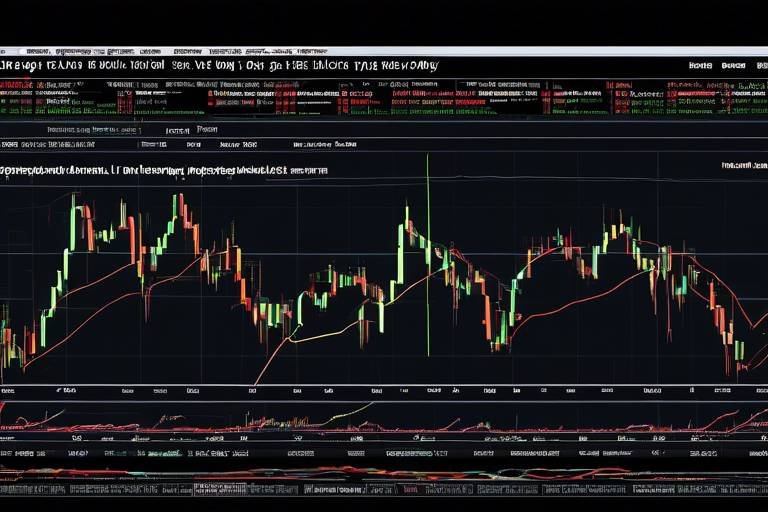Understanding the Impact of Market Sentiment
Market sentiment is like the pulse of the financial world; it reflects the collective feelings and attitudes of investors towards a particular market or asset. Just as a sudden storm can change the weather, shifts in market sentiment can dramatically influence stock prices and overall market trends. When investors are feeling optimistic, they tend to buy more, driving prices up. Conversely, when fear grips the market, selling can ensue, leading to price declines. This psychological aspect of investing is critical for anyone looking to navigate the complex waters of the financial markets.
To fully grasp the impact of market sentiment, it's essential to understand that it is not just about the numbers on a chart; it encompasses emotions, beliefs, and perceptions. Think of it as a crowd at a concert—if the crowd is excited, the energy is electric, and everyone is dancing. However, if someone starts a rumor that the concert is about to end, the crowd may become anxious and start to leave. Similarly, in the financial markets, news, social media chatter, and even economic reports can shift sentiment in an instant.
Understanding market sentiment allows investors to make more informed decisions. It can help them identify potential opportunities or risks that may not be immediately apparent from traditional financial analysis. For instance, if a stock is seeing a surge in positive sentiment on social media, it might be worth investigating further, even if the underlying fundamentals appear stable. By tapping into the emotional drivers behind market movements, investors can enhance their strategies and potentially outperform their peers.
Moreover, market sentiment is often cyclical. During a bull market, optimism reigns supreme, and investors may overlook warning signs, leading to overvaluations. Conversely, in a bear market, pessimism can create undervalued opportunities. Recognizing these cycles can be the key to timing market entries and exits effectively. It’s a bit like surfing; catching the right wave at the right moment can lead to a thrilling ride, while missing it can mean getting tossed around in the water.
In summary, market sentiment is a powerful force that shapes the financial landscape. By understanding its dynamics, investors can better navigate the complexities of market behavior. As we dive deeper into this article, we will explore the role of investor psychology, sentiment analysis techniques, and various indicators that can help you decode the emotional undercurrents of the market.
- What is market sentiment?
Market sentiment refers to the overall attitude of investors towards a particular security or financial market. It is influenced by emotions and perceptions rather than just fundamental analysis. - How does market sentiment affect stock prices?
When investor sentiment is positive, demand for stocks increases, leading to higher prices. Conversely, negative sentiment can lead to selling pressure and falling prices. - What are some tools to measure market sentiment?
Common tools include the Fear & Greed Index, Consumer Confidence Index, and sentiment analysis from social media platforms. - Can market sentiment change quickly?
Yes, market sentiment can change rapidly due to news events, social media trends, or economic reports, making it crucial for investors to stay informed.

The Role of Investor Psychology
Investor psychology plays a pivotal role in shaping market sentiment, influencing how traders and investors react to various stimuli in the financial landscape. It's fascinating how emotions like fear and greed can sway decisions, sometimes leading to irrational behavior that defies logical analysis. Imagine standing on a cliff, peering down at the vast ocean; the thrill of the height can either inspire you to jump or paralyze you with fear. Similarly, in the world of investing, the psychological state of an investor can dictate whether they dive into a stock or retreat in panic.
Understanding these psychological factors is crucial for predicting market movements. For instance, during a bull market, investors often exhibit overconfidence, believing that prices will only continue to rise. This can create a feedback loop where rising prices fuel further optimism, leading to even higher valuations. Conversely, in a bear market, fear can spread like wildfire, causing a mass exodus from stocks, often at the worst possible time.
To illustrate how these emotions manifest in the market, consider the following scenarios:
| Emotion | Market Behavior | Investor Reaction |
|---|---|---|
| Greed | Rising stock prices | Increased buying, often at inflated prices |
| Fear | Falling stock prices | Mass selling, often resulting in losses |
Additionally, the concept of herd behavior is another psychological phenomenon that impacts market sentiment. Investors often look to others for cues on how to act. If everyone is buying a stock, an investor may feel compelled to join in, fearing they might miss out on potential gains. This can lead to bubbles, where prices soar far beyond their intrinsic value, only to crash when reality sets in.
Moreover, cognitive biases, such as the confirmation bias, can further complicate decision-making. Investors may seek out information that confirms their existing beliefs while ignoring data that contradicts them. This selective perception can create a distorted view of the market, leading to poor investment choices.
In conclusion, understanding the role of investor psychology is essential for anyone looking to navigate the complex world of finance. By recognizing the emotional drivers behind market movements, investors can better position themselves to make informed decisions, avoiding the pitfalls of fear and greed that often lead to costly mistakes.
- What is investor psychology? Investor psychology refers to the emotional and cognitive factors that influence investors' decisions in the financial markets.
- How does fear affect investment decisions? Fear can lead to panic selling, causing investors to sell stocks at a loss when prices drop.
- What role does greed play in investing? Greed often drives investors to take excessive risks, leading to overvalued stocks and potential market bubbles.
- Can understanding investor psychology improve my trading strategy? Yes, by recognizing emotional biases and market sentiment, investors can make more rational and informed decisions.

Sentiment Analysis Techniques
Sentiment analysis is like having a crystal ball for the stock market, providing investors with insights into the mood of the masses. It employs various techniques that allow us to gauge public opinion and understand how it can influence market trends. By tapping into the collective psyche of investors, we can predict potential shifts in stock prices and market behavior. But how exactly do these techniques work? Let's dive into the world of sentiment analysis!
One of the most prominent methods used in sentiment analysis is social media monitoring. With platforms like Twitter and Reddit buzzing with discussions about stocks, analyzing these conversations can reveal a lot about investor sentiment. For example, if a particular stock is trending on Twitter, it might indicate a growing interest or concern among investors. This real-time data can be a goldmine for traders looking to catch the next wave of market movement.
Another effective technique is news sentiment scoring. This method involves evaluating news articles and headlines to determine their emotional tone. Are they positive, negative, or neutral? By assigning scores to these articles, investors can quickly assess how news coverage might affect market sentiment. For instance, a flurry of positive news about a technology company could lead to a surge in stock prices, while negative headlines could trigger panic selling.
Social media platforms are not just for sharing cute cat videos; they have become powerful tools for shaping market sentiment. When investors engage in real-time discussions about stocks, their collective opinions can significantly impact market trends. For instance, a viral tweet about a stock can lead to a sudden influx of buying or selling activity. This phenomenon highlights the importance of monitoring social media trends to stay ahead of the curve.
Twitter sentiment metrics can provide immediate insights into market reactions. By analyzing trending topics and hashtags, investors can gauge public sentiment and potential market movements. For example, if a stock is consistently mentioned in a positive light, it might indicate a bullish sentiment. Conversely, if the chatter turns negative, investors may want to reconsider their positions.
Reddit has emerged as a formidable force in market sentiment, particularly with the rise of meme stocks. Communities like WallStreetBets have shown just how powerful collective sentiment can be. When a group of investors rallies around a particular stock, they can drive significant price movements through their discussions and shared enthusiasm. This phenomenon underscores the importance of understanding the dynamics of online communities and their potential impact on the market.
In conclusion, sentiment analysis techniques provide invaluable insights into the psychological factors driving financial decisions. By leveraging social media monitoring and news sentiment scoring, investors can better understand market trends and make informed decisions. As the landscape of investing continues to evolve, staying attuned to the mood of the market has never been more critical.
- What is sentiment analysis? Sentiment analysis is the process of evaluating public opinion, particularly in financial markets, to gauge investor sentiment and predict market movements.
- How does social media influence market sentiment? Social media platforms allow investors to share their opinions in real-time, which can lead to significant price movements based on collective sentiment.
- What are some common sentiment analysis techniques? Common techniques include social media monitoring, news sentiment scoring, and analyzing sentiment metrics from various platforms.
- Why is understanding market sentiment important? Understanding market sentiment helps investors make informed decisions, anticipate market trends, and improve their trading strategies.

Social Media Influence
In today's digital age, social media has become a powerful catalyst for shaping market sentiment. Just think about it: a single tweet or a viral post can send stock prices soaring or crashing within minutes. This phenomenon highlights how real-time discussions on platforms like Twitter, Reddit, and Facebook can significantly impact investor perceptions and decisions. Investors no longer rely solely on traditional news sources; they now turn to social media for the latest buzz, sentiment analysis, and even investment advice.
One of the most fascinating aspects of social media is its ability to create a collective consciousness among users. When a particular stock starts trending, the conversations around it can create a snowball effect, attracting more attention and driving prices in a specific direction. For instance, the rise of meme stocks, driven primarily by discussions on Reddit, demonstrates how a community can rally around a stock, generating a frenzy that traditional financial metrics might not predict. It's like watching a wildfire spread; once it catches on, it can be hard to contain.
To illustrate the impact of social media on market sentiment, consider the following factors:
- Real-Time Feedback: Social media provides immediate reactions to market events, allowing investors to gauge public sentiment quickly.
- Trend Identification: By monitoring trending topics and hashtags, investors can identify emerging market trends before they become mainstream.
- Influencer Impact: Influencers and thought leaders on these platforms can sway opinions and drive significant market movements simply by sharing their insights.
Moreover, the interactivity of social media fosters a sense of community among investors. Platforms like Twitter allow users to share their thoughts, engage in discussions, and even debate investment strategies. This interaction can lead to a more informed investor base but can also create echo chambers where certain sentiments are amplified, regardless of their validity. It's essential to navigate this space cautiously; while social media can be a treasure trove of insights, it can also lead to impulsive decisions driven by hype rather than solid analysis.
In conclusion, the influence of social media on market sentiment is undeniable. As investors become increasingly reliant on these platforms for information and community, understanding how to interpret the noise and discern valuable insights will be crucial for making informed investment decisions. Just remember, in the world of finance, what goes viral can sometimes lead to a rollercoaster ride of emotions, so stay grounded and do your homework!
Q: How does social media affect stock prices?
A: Social media can influence stock prices by creating hype or panic around a particular stock, often leading to rapid price changes based on sentiment rather than fundamentals.
Q: What are meme stocks?
A: Meme stocks are shares that gain popularity through social media discussions, often leading to significant price fluctuations driven by collective sentiment rather than traditional financial metrics.
Q: Can I rely solely on social media for investment decisions?
A: While social media can provide valuable insights, it's essential to combine this information with thorough research and analysis to make informed investment decisions.

Twitter Sentiment Metrics
In the fast-paced world of finance, have emerged as a vital tool for investors looking to gauge public opinion and market reactions. With millions of tweets generated every day, the platform serves as a real-time barometer of investor sentiment. Imagine walking into a crowded room and being able to sense the mood just by listening to the chatter—this is what Twitter sentiment analysis aims to achieve in the financial markets.
By analyzing trending topics, hashtags, and the overall tone of tweets related to specific stocks or market events, investors can gain immediate insights into how the public perceives certain investments. For instance, a surge in positive tweets about a tech company could indicate a bullish sentiment, potentially driving the stock price up. Conversely, a wave of negative commentary may signal trouble, prompting investors to rethink their positions.
One effective method of measuring Twitter sentiment is through sentiment scoring, where tweets are classified as positive, negative, or neutral. This scoring can be displayed in a simple sentiment score table that helps investors quickly understand the prevailing mood. Here's an example:
| Sentiment Type | Percentage of Tweets |
|---|---|
| Positive | 65% |
| Negative | 20% |
| Neutral | 15% |
These metrics can be particularly useful during earnings reports or significant market events. Investors can monitor the Twitter sentiment surrounding these moments to anticipate potential market movements. For example, if a company is about to release its quarterly earnings and there is a spike in positive sentiment on Twitter, it could indicate that investors are optimistic about the results. On the flip side, if negative sentiment prevails, it might be wise to exercise caution.
Moreover, Twitter sentiment metrics can also help in identifying emerging trends. By keeping an eye on the volume of tweets and the sentiment associated with them, investors can spot new opportunities or potential pitfalls before they become mainstream. It’s like having a crystal ball that reveals the thoughts and feelings of the market in real-time.
However, it’s essential to approach these metrics with a grain of salt. Not all tweets reflect informed opinions; some may be driven by hype, misinformation, or even coordinated efforts to manipulate stock prices. Therefore, while Twitter sentiment metrics are valuable, they should be used in conjunction with other analytical tools and fundamental research.
In conclusion, Twitter sentiment metrics provide a fascinating glimpse into the collective psyche of investors. By leveraging these insights, traders can make more informed decisions, react quickly to market changes, and potentially enhance their investment strategies. In the ever-evolving landscape of finance, staying attuned to the pulse of social media can be a game-changer.
- What are Twitter sentiment metrics? Twitter sentiment metrics are analyses that gauge the overall sentiment expressed in tweets about specific stocks or market events, helping investors understand public opinion.
- How can I use Twitter sentiment in my investment strategy? You can monitor Twitter sentiment to identify trends, gauge market reactions to news, and adjust your investment strategies accordingly.
- Are Twitter sentiment metrics always accurate? While they provide valuable insights, they should be used alongside other analytical tools, as not all tweets reflect informed opinions.

Reddit and Meme Stocks
In recent years, Reddit has transformed from a simple discussion forum into a formidable player in the financial markets, particularly through the phenomenon of meme stocks. These stocks, often characterized by their rapid price movements driven by social media hype rather than fundamental analysis, have captured the attention of both seasoned investors and newcomers alike. But what exactly is it about Reddit that makes it such a powerful force in shaping market sentiment?
At the heart of this movement is the community aspect of Reddit, particularly in subreddits like r/WallStreetBets. Here, users share not just investment strategies but also memes, jokes, and a sense of camaraderie that can influence stock prices in real-time. The collective energy of these communities can lead to significant price surges, as seen with stocks like GameStop and AMC Entertainment. These stocks became household names, not because of traditional market metrics, but due to the viral nature of discussions and the sheer enthusiasm of retail investors rallying around them.
One of the most fascinating aspects of meme stocks is how they embody the fear of missing out (FOMO). When a stock starts trending on Reddit, it often leads to a rush of buying activity, as investors scramble to get in on the action before prices skyrocket. This can create a feedback loop where rising prices attract even more attention, further fueling the hype. It's almost like a digital wildfire, where the initial spark of interest can lead to an uncontrollable blaze of trading activity.
Moreover, the influence of Reddit extends beyond just individual stocks. It has prompted a broader conversation about the role of retail investors in the market. Traditionally, institutional investors dominated the landscape, but the rise of social media platforms has leveled the playing field, allowing everyday investors to band together and challenge the status quo. This shift raises important questions about market dynamics and the power of collective action.
However, while the excitement surrounding meme stocks can be exhilarating, it also comes with risks. The volatility associated with these stocks can lead to significant losses, especially for those who jump in without a clear strategy. Understanding the sentiment driving these movements is crucial for any investor looking to navigate this new landscape. It’s essential to approach meme stocks with a healthy dose of skepticism and a well-thought-out strategy.
In conclusion, Reddit has become a key player in the world of meme stocks, turning the stock market into a thrilling game where sentiment can change in the blink of an eye. As investors, being aware of these dynamics is vital, as it allows us to make more informed decisions in an environment that is increasingly influenced by social media and collective sentiment.
- What are meme stocks? Meme stocks are shares that gain popularity and experience significant price movements due to social media hype rather than traditional financial metrics.
- How does Reddit influence stock prices? Reddit influences stock prices through community discussions that can lead to collective buying or selling, often resulting in rapid price changes.
- What are the risks of investing in meme stocks? The primary risks include high volatility and the potential for significant losses, especially for those who invest without a solid strategy.
- Can retail investors really impact the market? Yes, the rise of social media has empowered retail investors to band together and influence market trends, challenging traditional institutional dominance.

News and Media Impact
The influence of news coverage on market sentiment cannot be overstated. In today's fast-paced financial world, headlines can sway investor opinions in mere moments. One minute, a positive earnings report can send stocks soaring, and the next, a negative news story can trigger a massive sell-off. This phenomenon highlights the power of perception—investors often react not just to the facts presented, but to the emotional weight those facts carry.
For instance, consider how a single tweet from a prominent figure can create ripples across the stock market. When news breaks, whether it's about a company’s merger or a global economic crisis, the initial reactions are often driven by fear or excitement. This reaction can lead to a domino effect, where one investor's panic leads to another's, creating a cascade of selling or buying pressure. Understanding this psychological impact is crucial for anyone looking to navigate the financial landscape effectively.
Furthermore, news cycles operate in a way that can amplify market movements. When a story gains traction, it often becomes a focal point for media outlets, leading to a cycle of coverage that can further influence investor sentiment. For example, during times of economic uncertainty, headlines about rising unemployment or inflation can create a climate of fear, prompting investors to pull back from the market. Conversely, positive news regarding job growth or technological advancements can instill confidence, encouraging investment.
To illustrate the significance of news coverage, let's take a look at a simple table that compares the impact of different types of news on market sentiment:
| Type of News | Investor Reaction | Market Impact |
|---|---|---|
| Positive Earnings Report | Increased buying | Stock price rises |
| Negative Economic Data | Panic selling | Stock price drops |
| Global Crisis (e.g., pandemic) | Heightened caution | Market volatility |
| New Product Launch | Optimism | Stock price increases |
As you can see, the type of news can significantly dictate how investors react, and thus, how the market behaves. This understanding can empower investors to make more informed decisions. By keeping an eye on the news and recognizing its potential impact, investors can better anticipate market movements and adjust their strategies accordingly.
In conclusion, the media's role in shaping market sentiment is profound. Investors must not only stay informed about the news but also develop a keen sense of how different narratives can influence their psychological state and, consequently, their investment choices. By doing so, they can navigate the often turbulent waters of the financial markets with greater confidence and foresight.
- How does news affect stock prices? News can lead to immediate reactions in stock prices as investors respond to new information, whether positive or negative.
- What types of news have the most impact? Economic reports, earnings announcements, and major global events tend to have the most significant influence on market sentiment.
- Can social media news affect the market? Absolutely! Social media platforms can amplify news stories, leading to rapid changes in investor sentiment and market behavior.

Market Sentiment Indicators
Market sentiment indicators are essential tools that help investors gauge the overall mood of the market. These indicators reflect the collective emotions and attitudes of market participants, often serving as a barometer for potential price movements. By understanding these indicators, investors can make more informed decisions, aligning their strategies with prevailing market conditions.
One of the most widely recognized sentiment indicators is the Fear & Greed Index. This index measures the emotions driving the market on a scale from extreme fear to extreme greed. When investors are fearful, they tend to sell off their assets, causing prices to drop. Conversely, when greed takes over, investors are more likely to buy, pushing prices higher. This cyclical nature of fear and greed can create opportunities for savvy investors who can read the signals.
Another important indicator is the Consumer Confidence Index (CCI). This index gauges how optimistic or pessimistic consumers feel about the economy, which directly impacts spending and investment behaviors. A high CCI often correlates with increased consumer spending, leading to economic growth and, consequently, a bullish market sentiment. Conversely, a low CCI can indicate economic troubles ahead, prompting investors to tread carefully.
To illustrate the relationship between these indicators and market sentiment, consider the following table:
| Indicator | Description | Impact on Market Sentiment |
|---|---|---|
| Fear & Greed Index | Measures the emotions of fear and greed among investors. | High greed can lead to market bubbles; high fear can lead to sell-offs. |
| Consumer Confidence Index | Reflects consumer optimism about the economy. | High confidence can drive spending and investment; low confidence can lead to market declines. |
| Volatility Index (VIX) | Measures market expectations of near-term volatility. | High VIX indicates fear; low VIX indicates complacency. |
Additionally, sentiment indicators can also include metrics like the Volatility Index (VIX), which gauges market expectations of near-term volatility. A high VIX often signifies increased fear among investors, suggesting that they expect significant market fluctuations. This can be a signal for cautious investors to reevaluate their positions. On the flip side, a low VIX indicates a sense of complacency, which can sometimes lead to unexpected market corrections.
Understanding these sentiment indicators is crucial for investors looking to navigate the complexities of the market. By keeping an eye on these metrics, investors can better anticipate potential shifts in market dynamics, allowing them to position themselves advantageously. For example, an investor noticing a spike in the Fear & Greed Index might decide to lock in profits before a potential downturn, whereas another observing a rise in the Consumer Confidence Index might choose to increase their equity exposure.
In conclusion, market sentiment indicators are not just numbers; they represent the collective psyche of investors. By interpreting these indicators wisely, you can enhance your investment strategies and improve your chances of success in the ever-changing financial landscape.
- What are market sentiment indicators? Market sentiment indicators are tools that help investors understand the emotional state of the market, influencing their investment decisions.
- How do I use the Fear & Greed Index? Monitor the index to gauge market sentiment. Extreme fear may indicate a buying opportunity, while extreme greed could signal a market correction.
- Is the Consumer Confidence Index important? Yes, it reflects consumer sentiment and can influence spending habits, impacting market trends significantly.
- What does a high VIX mean? A high VIX indicates increased market volatility and fear among investors, suggesting caution in trading strategies.

Technical Analysis of Sentiment
Technical analysis of sentiment is an intriguing approach that combines traditional market analysis with the psychological aspects of trading behavior. By examining price movements alongside sentiment data, investors can gain a deeper understanding of market dynamics. It's like trying to decode the emotional heartbeat of the market, where every price fluctuation tells a story influenced by investor sentiment.
One of the most compelling aspects of this analysis is the ability to identify potential market trends before they become apparent through conventional analysis. For instance, when prices are rising, but sentiment indicators show a decline in bullish sentiment, it could be a red flag. This divergence might suggest that the upward trend is losing steam, hinting at a possible reversal. Think of it as a warning light on your dashboard; while everything seems fine, there’s an underlying issue that needs attention.
To effectively utilize technical analysis of sentiment, traders often rely on various sentiment indicators. These can include:
- Relative Strength Index (RSI): This measures the speed and change of price movements, helping to identify overbought or oversold conditions.
- Moving Averages: These smooth out price data to identify trends over a specific period, allowing traders to see the bigger picture.
- Bollinger Bands: These bands adjust to volatility in the market, providing insights into potential price breakouts or reversals.
Incorporating sentiment analysis into technical analysis can also involve examining social media trends, news headlines, and even market volatility. For example, if a stock is trending on Twitter with overwhelmingly positive sentiment, yet the price is stagnant, it might indicate an upcoming breakout. This is where the real power of sentiment analysis shines, as it captures the collective mood of the market, which can sometimes act irrationally.
Moreover, understanding sentiment in relation to market cycles can provide critical insights. During bullish phases, sentiment tends to be overly optimistic, leading to potential bubbles. Conversely, in bearish markets, fear can dominate, pushing prices down even when fundamentals may not justify such declines. By analyzing sentiment alongside these cycles, traders can better time their entries and exits, maximizing their potential for profit.
In summary, technical analysis of sentiment is not just about charts and numbers; it's about understanding the emotional currents that drive market behavior. By blending traditional technical analysis with sentiment indicators, investors can develop a more nuanced approach to trading. This method not only enhances their ability to predict market movements but also empowers them to make more informed decisions in an ever-changing financial landscape.
What is technical analysis of sentiment?
Technical analysis of sentiment involves combining traditional market analysis with psychological factors to understand market dynamics and predict trends.
How can sentiment indicators help in trading?
Sentiment indicators can highlight market mood and potential reversals, allowing traders to make more informed decisions about their trades.
What are some common sentiment indicators?
Common sentiment indicators include the Relative Strength Index (RSI), Moving Averages, and Bollinger Bands, among others.
Why is it important to consider sentiment in market analysis?
Considering sentiment is crucial because it reflects the emotional state of investors, which can lead to irrational market behavior that traditional analysis might miss.

Sentiment and Economic Indicators
Understanding the relationship between market sentiment and economic indicators is crucial for investors looking to navigate the turbulent waters of financial markets. Just like the weather, market sentiment can shift dramatically based on various economic conditions, and recognizing these patterns can be the key to making informed investment decisions. For instance, when economic indicators like unemployment rates or GDP growth show signs of improvement, it often breeds a sense of optimism among investors. This optimism can lead to increased buying activity, pushing stock prices higher and enhancing overall market sentiment.
Conversely, when economic indicators are less favorable, such as rising unemployment or stagnant GDP growth, fear can quickly take hold. Investors may panic, leading to a sell-off in the markets. This phenomenon highlights the psychological aspect of investing, where emotions can override logical decision-making. It’s fascinating how the collective mood of investors can be swayed by numbers that reflect the broader economy, isn’t it?
To illustrate this relationship further, let’s take a look at some key economic indicators and how they typically affect market sentiment:
| Economic Indicator | Typical Impact on Market Sentiment |
|---|---|
| Unemployment Rate | Higher rates can lead to negative sentiment; lower rates generally boost confidence. |
| GDP Growth | Strong growth often correlates with positive sentiment; weak growth can cause pessimism. |
| Consumer Confidence Index | High confidence levels usually result in bullish sentiment; low levels can trigger bearish reactions. |
| Inflation Rate | Rising inflation can create uncertainty, affecting sentiment negatively; controlled inflation can boost confidence. |
As you can see, these indicators do not just exist in isolation; they interact with one another and contribute to the overall market sentiment. For example, if the unemployment rate drops, it often leads to increased consumer spending, which in turn can drive GDP growth. This cycle of positive feedback can create a robust atmosphere of optimism, encouraging investors to take risks and invest more heavily in the market.
However, it’s important to remember that while economic indicators play a significant role in shaping market sentiment, they are not the only factors at play. Global events, geopolitical tensions, and even social movements can disrupt the delicate balance of investor psychology. Therefore, savvy investors should always keep an eye on both economic data and the prevailing mood in the market to make the best decisions for their portfolios.
In conclusion, the interplay between sentiment and economic indicators is a dance of sorts—one that requires careful observation and analysis. By understanding how these elements interact, investors can better position themselves to capitalize on opportunities and mitigate risks. So, the next time you hear a report on economic indicators, consider how they might influence the collective sentiment of the market. It could be the difference between a wise investment and a costly mistake!
- What is market sentiment? Market sentiment refers to the overall attitude of investors toward a particular security or financial market. It can be influenced by various factors, including economic indicators, news, and social media trends.
- How do economic indicators affect market sentiment? Economic indicators provide insights into the health of the economy. Positive indicators can boost investor confidence and sentiment, while negative indicators can lead to fear and pessimism.
- Can market sentiment change quickly? Yes, market sentiment can change rapidly, often in response to new information or events, such as earnings reports, economic data releases, or geopolitical developments.
- Why is it important to monitor market sentiment? Monitoring market sentiment can help investors identify trends, make informed decisions, and better understand potential market movements.
Frequently Asked Questions
- What is market sentiment?
Market sentiment refers to the overall attitude of investors toward a particular security or financial market. It’s often driven by emotions like fear and greed, which can significantly influence market trends and stock prices.
- How does investor psychology affect market sentiment?
Investor psychology plays a crucial role in shaping market sentiment. Emotional responses to market events, news, and trends can lead to irrational decision-making, which in turn affects stock prices and market movements.
- What techniques are used in sentiment analysis?
Sentiment analysis employs various techniques including social media monitoring, news sentiment scoring, and the analysis of market trends. These methods help gauge public opinion and identify shifts in investor sentiment.
- How does social media influence market sentiment?
Social media platforms are powerful tools for shaping market sentiment. Real-time discussions and trending topics on platforms like Twitter and Reddit can sway investor perceptions and lead to significant price movements.
- What are Twitter sentiment metrics?
Twitter sentiment metrics provide immediate insights into how investors are reacting to market events. By analyzing trending hashtags and topics, investors can gauge public sentiment and anticipate potential market movements.
- What role does news coverage play in market sentiment?
News coverage has a significant impact on market sentiment. Headlines and news cycles can influence investor perceptions and emotions, which ultimately affect market reactions to various events.
- What are some common market sentiment indicators?
Common market sentiment indicators include the Fear & Greed Index and the Consumer Confidence Index. These tools help investors assess the overall mood of the market and make more informed decisions.
- How can technical analysis be used with sentiment indicators?
Technical analysis can incorporate sentiment indicators to identify potential market trends. By examining price movements alongside sentiment data, investors can enhance their trading strategies and timing.
- How do economic indicators relate to market sentiment?
Economic indicators, such as unemployment rates and GDP growth, interact with market sentiment. Understanding this relationship allows investors to contextualize market movements within the broader economic landscape.


















